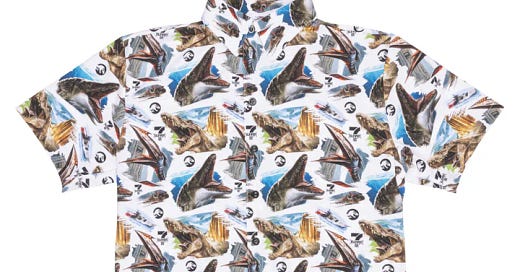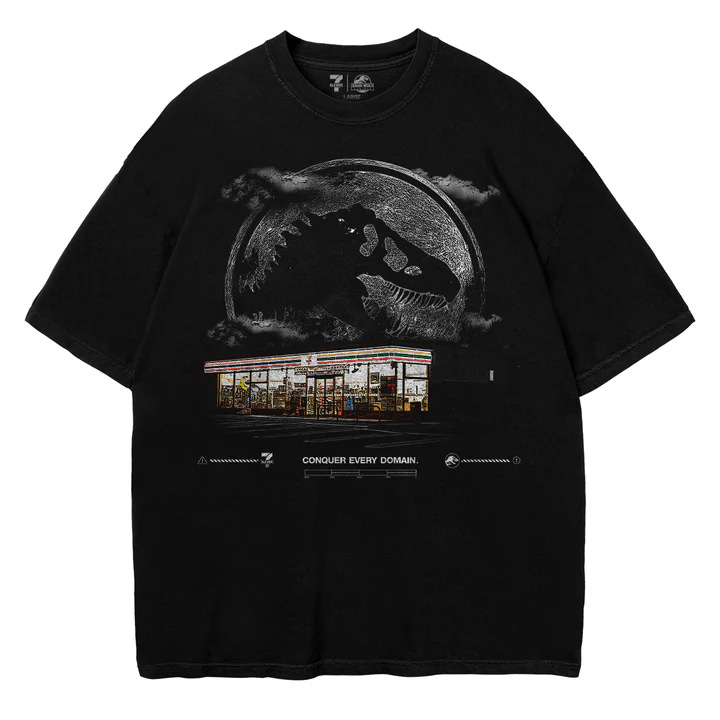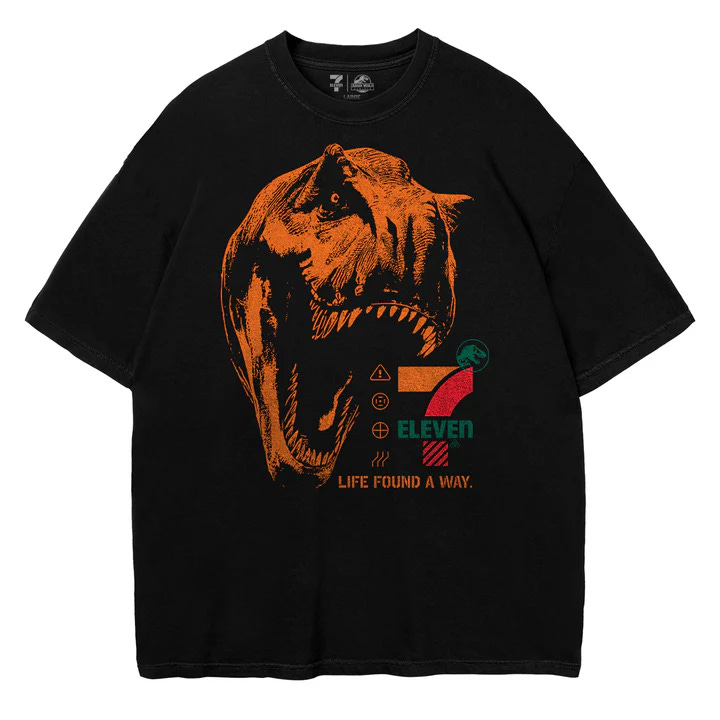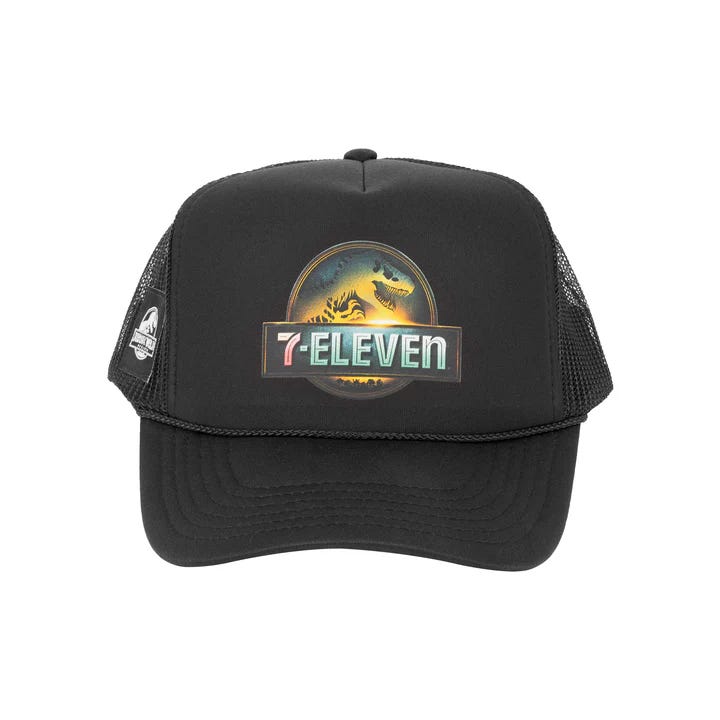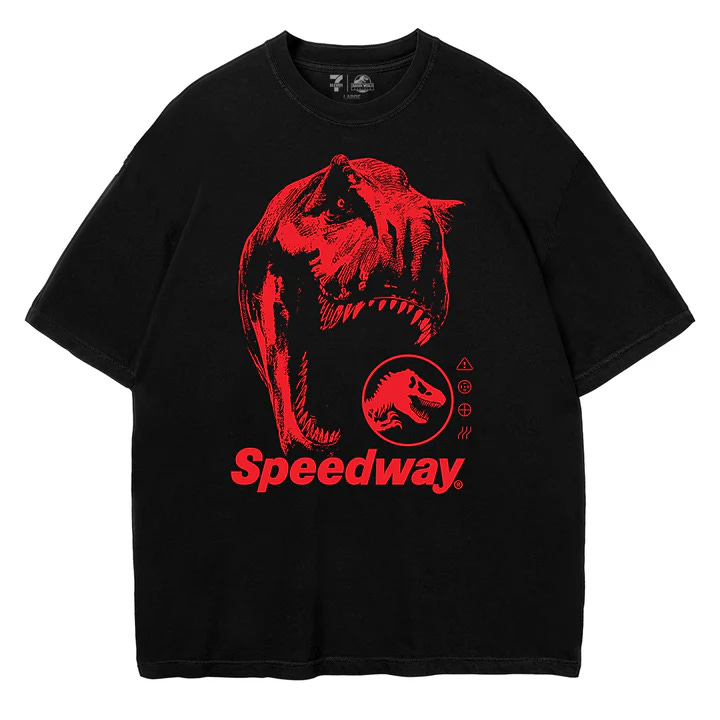7-Eleven x Jurassic World Rebirth Collection Review
Somewhere between a promotional tie-in and a slow motion cultural hallucination, the 7-Eleven x Jurassic World Rebirth apparel collection arrives like a fossil dragged through the gift shop of the Anthropocene. What began as a marketing campaign has metastasized into an accidental thesis on spectacle, extinction, and snack based semiotics. Here, corporate logos and prehistoric creatures share fabric real estate not in parody but in apparent sincerity, offering the uncanny suggestion that dinosaurs did not just survive; they franchised.
Each garment in the collection, including shirts and hats, acts as a wearable billboard for a retail dinosaur convergence and offers its own fragment of a larger visual mythology. This is not just merchandise. It is a material archive of branded surrealism, stitched with the earnestness of a world where catastrophe must always be accompanied by combo deals.
In the following reviews, each piece is examined on its own terms as design, as ideology, and as artifact. Together they form a catalog of strange devotion, garments less worn than witnessed. This is the latest form of franchise immersion. It is not theme park, not cinema, but costumed prophecy.
If the island of Dr. Moreau had hosted a Hawaiian luau, this is what the staff uniforms might have looked like. The 7-Eleven® x Jurassic World Rebirth Vacation Shirt ($60) arrives not with subtlety but with the maximalist fervor of a failing post pop civilization. Every square inch is saturated with cinematic beasts including Titanosaurus, Mosasaurus, and Quetzalcoatlus repeating in aggressive pattern like an overmedicated Rousseau painting reinterpreted for the clearance rack at Spencer’s Gifts. What could have been a simple promotional garment becomes, through sheer excess, a wearable mood board of franchise delirium.
The visual density is unnerving. Dinosaurs collide with convenience store logos in a compositional logic that owes more to early Photoshop collage than textile design. It evokes a kind of late capitalist cubism, with flattened signifiers of danger, wonder, and discount branding all vying for legibility. Like Warhol’s Disaster Series inverted through polyester, the shirt does not commemorate extinction; it merchandises it. The stitched Jurassic World Rebirth tag near the hem functions as a seal of post ironic approval, a relic of fear rebranded for leisurewear.
As an object, it resists both function and fashion. It is not quite wearable, and certainly not breathable. But in its visual cacophony lies a certain purity, an earnestness so garish it becomes sublime. This is not a shirt. It is a fresco of corporate myth-making rendered in synthetic thread, a monument to the idea that spectacle can be printed, worn, and machine washed cold.
If Giorgio de Chirico had discovered screen printing and a fondness for convenience stores, the result might resemble this black cotton reliquary of fossilized commerce. Here, against a void-like ground of noir black, Jurassic fauna emerge not as narrative devices but as floating signifiers in a twilight of logos. A raptor, a Mosasaurus, a looming T-rex: they do not move. They assert. They do not stalk. They brand.
Dominating the composition is the 7-Eleven logo, rendered in distressed industrial orange and reframed as a kind of monolithic cipher. It is equal parts petrol station and postapocalyptic monument. It hovers in visual tension with a faux tech motif of hazard stripes and circuitry, suggesting the convergence of bioengineering and supply chain logistics. Beneath it, the Jurassic World Rebirth insignia forms the shirt’s visual plinth, rooting its semiotics in the franchise’s iconography. It also echoes Soviet propagandistic idealism, where extinction is repackaged as glorious inevitability.
The palette, orange on black, evokes both lava flow and caution tape, transforming the tee into wearable disaster signage. It is as if a graphic designer in a fallout shelter was tasked with commemorating the end of both dinosaurs and design ethics. The effect is almost devotional, a dark icon for the church of branded entropy.
As fashion, it resists seasonality. As art, it whispers a quiet truth. This is what myth looks like when sponsored by a beverage retailer.
This is the masterpiece of the collection, a noir pastoral of suburban apocalypse rendered in cotton. Where the previous entries in the series traffic in spectacle, this shirt dares to conjure atmosphere. A lone 7-Eleven glows in hyperrealist fidelity, lit like a Hopper painting if Hopper had shopped at gas stations and feared the sky. Hovering above it, monumental and moonlit, is the skeletal profile of a T-rex, its grin etched like a coin face of ancient violence.
The pairing of the two images, the glowing convenience store and the cosmic predator, feels like a still from a lost Chris Marker film or an ad campaign devised by Robert Longo mid nightmare. The tagline below, “CONQUER EVERY DOMAIN,” is less slogan than threat, an ambiguous imperative from a dying empire or an AI written psalm. The typography is minimal and machinic. The imagery, haunted.
This shirt does not peddle excitement. It peddles dread, polished and wearable. It is art direction as prophecy. The new world order will not arrive by thunderous footsteps but under flickering fluorescents, with Raptor Vanilla Swirl Cakebites and Slurpee straws. The dinosaur does not break through the glass. It becomes the brand.
One can imagine this piece hanging next to an Ed Atkins installation or projected in a museum vitrine titled Late Anthropocene Retail Culture (Recovered Apparel, 2025). It is not merch. It is memorial.
This shirt is less fashion and more prophecy, an artifact of branded Darwinism. Dominating the chest is a jagged, vectorized T-rex head in a spectral orange, its maw agape as if mid-roar or mid-consumption of a $5 pizza. The effect is arresting, almost devotional. This is not the scientific precision of paleoart, but the heraldic iconography of empire. And not just any empire. 7-Eleven, here rendered in its retro mod color scheme, is positioned as the evolutionary endpoint.
Beneath the snarling visage, the phrase “LIFE FOUND A WAY” appears in terminal caps, a quote lifted from Goldblum’s chaos theorist drawl and repurposed here as theological branding. It is less an affirmation of biology than a grim celebration of market adaptation, an unholy union of entropy and retail. Flanking the text are a cryptic suite of graphic symbols, biohazard like glyphs and caution signs that feel almost alchemical in their opacity. It is unclear whether they signify mutation, marketing, or merely the aesthetic of digital danger. They may, in fact, be telling us that this garment is dishwasher safe.
There is something Francis Bacon adjacent in the rendering of the dinosaur’s face, a scream caught mid transmission, a distortion of instinct reframed through screenprint. But where Bacon’s figures grapple with existential despair, this one sells Big Gulps. It does not mourn the past. It monetizes it.
This shirt is not merely about dinosaurs or snacks. It is about survival, and about who gets to put their logo on it.
If logos are the power sigils of the early 21st century, then this trucker hat is its ceremonial crown. A black foam panel becomes the stage for a surreal corporate palimpsest. The Jurassic Park emblem, universally imprinted in the cultural unconscious, is overlaid with the 7-Eleven wordmark, retro futuristically rendered in a chrome glow font that evokes both VHS tape sleeves and dive bar neon. It is an uncanny synthesis, an act of visual ventriloquy in which the convenience store speaks through the fossilized mouth of the dinosaur.
More than any garment in the collection, this piece leans fully into simulacrum. The 7-Eleven logo does not sit atop the Jurassic Park insignia. It replaces it. The consumer is no longer visiting a film branded retailer. The retailer is the franchise. This hat does not represent crossover. It represents absorption.
Structurally, the hat is pure Americana. Mesh back, curved bill, a silhouette beloved by both ranchers and hypebeasts. It evokes the kind of functional accessory one might wear to a demolition derby or an ironic dive into truck stop aesthetics. But worn in this context, it becomes a crown of hyperreality, where memory, movie, and market collapse into a single wearable glyph.
It is both absurd and profound, a relic of the Anthropocene where predator and retailer share equal billing. A hat that asks: if evolution had a brand sponsor, would it be Coke or Pepsi?
This shirt feels less like merchandise and more like the official uniform of a paramilitary fossil cult. This 7-Eleven x Jurassic World Rebirth tee dispenses with the playful chaos of its 7-Eleven siblings and opts instead for stark confrontation. A red on black palette recalls the silkscreened ferocity of early 1980s anarcho punk zines or the red monochrome death ritual flags of obscure micronations. The T. rex, rendered in jagged contours, looms not as icon but as warning, somewhere between a cave painting and a kill marker.
Beneath the beast, the Speedway wordmark is printed with the kind of certainty normally reserved for state propaganda. It reads less like a brand and more like a declaration, of velocity, of combustion, of terminal convenience. The arrangement conjures the spirit of Tomas Schmit’s Fluxus era refusal to separate absurdity from system. Here, the irrational is industrialized. The irrational is screen printed.
A series of accompanying symbols, ambiguous runes suggesting motion, temperature, rotation, punctuate the composition with the precision of data visualization repurposed for theology. These aren’t embellishments. They’re ciphers, gesturing toward a mythology of asphalt and appetite.
More than any other piece in the collection, this shirt invites the wearer not to consume, but to align. To pledge allegiance to a vision of modernity where extinction isn’t feared but merchandised.
This shirt is a blacksite of aesthetic intent, a surveillance montage of beasts frozen mid charge, mid screech, mid brand alignment. Rendered in grayscale with high gloss precision, the shirt features the core trio of Jurassic World Rebirth’s apex creatures: land, sea, and sky, layered like surveillance stills or archival footage from a disaster that has been commodified into fandom. At its heart lies the Speedway wordmark, printed in distressed red like a corrupted file header or a bloodstain on a faxed transmission from the edge of a theme park war zone.
There is a coldness here, but it is calculated. The visual logic borrows less from movie posters than from late period Constructivism reinterpreted by corporate R&D. Diagonal hazard lines, techno inflected borders, and barcode-esque elements cut across the scene like fail safes that did not. Each element appears tagged and documented, as if we are not celebrating these creatures but monitoring them.
The shirt’s emotional register is not excitement but contingency. It suggests a world where the dinosaur is less creature than contingency plan, where biological spectacle has been subsumed into the same infrastructure that sells Rockin’ Rainbow energy drink and hot dog flavored potato chips. It does not say look at what we have made. It says look at what we have to manage.


